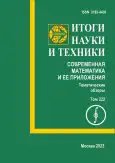Vol 222 (2023)
Articles
Geometry of almost 3-quasi-Sasakian manifolds of the second kind
Abstract
In this paper, we define the structure of an almost 3-quasi-Sasakian manifold of the second kind and prove that on a zero-curvature distribution of an almost quasi-Sasakian manifold, the structure of an almost 3-quasi-Sasakian manifold is determined by a connection with skew-symmetric torsion.
 3-9
3-9


Geometry of cyclic and anticyclic spaces
Abstract
We consider spaces whose geometry is determined by forms that are not quadratic. These forms are related to cyclic and anticyclic linear algebras. We describe linear transformations that preserve these forms and indicate invariants of these transformations similar to the distance between points and the angle between vectors.
 10-18
10-18


Invariant Ricci solitons on metric Lie groups with a semisymmetric connection
Abstract
In this paper, we examine invariant Ricci solitons on three-dimensional unimodular Lie groups with a semisymmetric connection. We prove that nontrivial invariant Ricci solitons exist on some three-dimensional Lie groups with a left-invariant (pseudo) Riemannian metric and a semisymmetric connection different from the Levi-Civita connection. A complete classification of nontrivial invariant Ricci solitons and the corresponding semisymmetric connections on three-dimensional Lie groups is obtained.
 19-29
19-29


On the limits of Kahler-Ricci flow on Fano group compactifications
Abstract
Let G be a connected, complex reductive group. In this paper, we review the results on semistable limit of Q-Fano compactifications and the characterization of minimizers of Futaki invariants. Using the algebraic uniqueness, we construct the limiting space of the Kahler-Ricci flow on Fano group compactifications of rank 2.
 30-41
30-41


Stabilization of stationary motions of a satellite near the center of mass in a geomagnetic field. III
Abstract
In this paper, we consider problems of stabilization of stationary motions (equilibrium positions and regular precessions) of a satellite near the center of mass in gravitational and magnetic fields under the assumption that the center of mass moves in a circular orbit. Mathematical models of the problems considered are systems of differential equations with periodic coefficients. We present a rigorous analytical approach to this problem, which allows efficient and correct construction of stabilization algorithms. The method is based on the reducibility of nonstationary systems that describe these problems to stationary systems. Solutions for a number of problems of stabilizing stationary motions of a satellite with the help of magnetic systems are proposed. We present the results of mathematical modeling of the algorithms, which confirm the effectiveness of the developed methodology. This paper is the third part of the work. The first part is: Itogi Nauki i Tekhniki. Sovremennaya Matematika i Ee Prilozheniya. Tematicheskie Obzory. — 2023. — 220. — P. 71-85. The second part is: Itogi Nauki i Tekhniki. Sovremennaya Matematika i Ee Prilozheniya. Tematicheskie Obzory. — 2023. — 221. — P. 71-92.
 42-63
42-63


 64-68
64-68


On mutual arrangements of two M-curves of degree 4
Abstract
We consider the problem of topological classification of mutual arrangements in the real projective plane of two M -curves of degree 4. We study arrangements under the maximality condition (the oval of one of these curves has 16 pairwise distinct common points with the oval of the other curve) and some combinatorial condition to select a special type of such arrangements. We list pairwise different topological models of arrangements of this type that satisfy the topological consequences of Bezout’s theorem. There are more than 2000 such models. Examples of curves of degree 8 realizing some of these models are given; we prove that 1728 models cannot be realized by curves of degree 8. Proofs of the nonrealizability are performed out by Orevkov’s method based on the theory of braids and links.
 69-82
69-82


 83-93
83-93


 94-99
94-99


On Weil bundles
Abstract
In the paper, some lifts of tensor fields and linear connections given on a smooth manifold of the class to its Weil bundle are considered. A brief review of results on the theory of second-order Weil bundles obtained in recent years is given.
 100-114
100-114


Spontaneous clustering in Markov chains. III. Monte Carlo algorithms
Abstract
The third (final) part of the review on the modeling of spontaneous clustering of correlated point sets based on the statistics of nodes of Markov chains. Dedicated to the computational aspects of this problem, it contains a brief introduction into the method of statistical modeling (Monte Carlo method) and a detailed presentation of the specifics of its application to the problem under consideration, including solving the Ornstein-Zernike equation with the Levy-Feldheim stable kernel.
The necessary information from the theory of non-Gaussian stable distributions is given, an algorithm for modeling 3-dimensional vectors with a symmetric stable distribution is described, its justification is given, accompanied by graphical and tabular material. In conclusion, the test results are presented.
The first part of this work: Itogi Nauki i Tekhniki. Sovremennaya Matematika i Ee Prilozheniya. Tematicheskie Obzory. — 2023. — 220. — P. 125-144. The second part of this work: Itogi Nauki i Tekhniki. Sovremennaya Matematika i Ee Prilozheniya. Tematicheskie Obzory. — 2023. — 221. — P. 128-147.
 115-133
115-133


On Cartan’s canonical projective connectioN
Abstract
The projective Cartan connection is reduced to the canonical form using the deformation tensor, which is an extended torsion tensor. The curvature-torsion tensor of the canonical projective connection is degenerated into an analog of the centroprojective curvature tensor. The projective connection becomes canonical only when the extended torsion tensor vanishes.
 134-140
134-140


Lie algebras and special functions related to the isotropic cone
Abstract
In this paper, we discuss the relationship between some maximal subalgebras of the Lie algebra of the proper three-dimensional Lorentz group G and some special functions: Bessel and Bessel- Clifford functions, wave Coulomb functions, the Appel hypergeometric function F1, etc. The kernels of integral operators in the space of representations are expressed in terms of the function introduced by the authors. For this function, we derive continual addition theorems, which, in turn, lead to integral formulas for special functions. We briefly discuss similar results related to groups similar to G.
 141-152
141-152







